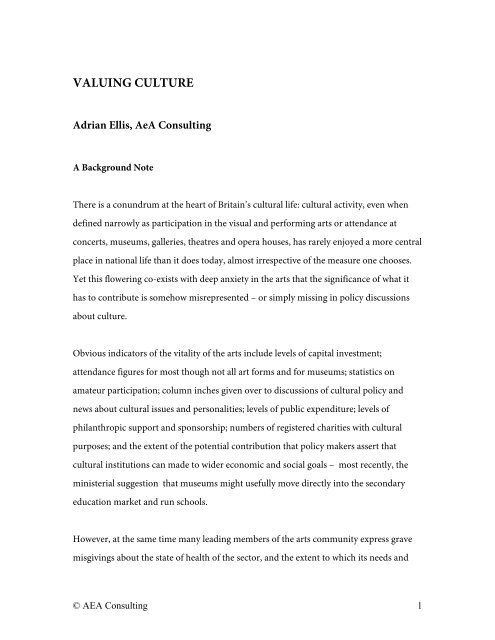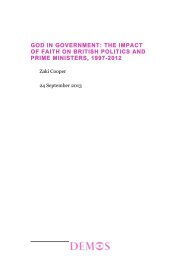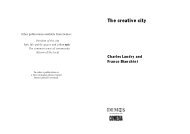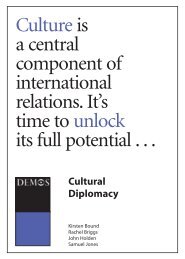Adrian Ellis, Director of AeA Consulting - Demos
Adrian Ellis, Director of AeA Consulting - Demos
Adrian Ellis, Director of AeA Consulting - Demos
Create successful ePaper yourself
Turn your PDF publications into a flip-book with our unique Google optimized e-Paper software.
VALUING CULTURE<br />
<strong>Adrian</strong> <strong>Ellis</strong>, <strong>AeA</strong> <strong>Consulting</strong><br />
A Background Note<br />
There is a conundrum at the heart <strong>of</strong> Britain’s cultural life: cultural activity, even when<br />
defined narrowly as participation in the visual and performing arts or attendance at<br />
concerts, museums, galleries, theatres and opera houses, has rarely enjoyed a more central<br />
place in national life than it does today, almost irrespective <strong>of</strong> the measure one chooses.<br />
Yet this flowering co-exists with deep anxiety in the arts that the significance <strong>of</strong> what it<br />
has to contribute is somehow misrepresented – or simply missing in policy discussions<br />
about culture.<br />
Obvious indicators <strong>of</strong> the vitality <strong>of</strong> the arts include levels <strong>of</strong> capital investment;<br />
attendance figures for most though not all art forms and for museums; statistics on<br />
amateur participation; column inches given over to discussions <strong>of</strong> cultural policy and<br />
news about cultural issues and personalities; levels <strong>of</strong> public expenditure; levels <strong>of</strong><br />
philanthropic support and sponsorship; numbers <strong>of</strong> registered charities with cultural<br />
purposes; and the extent <strong>of</strong> the potential contribution that policy makers assert that<br />
cultural institutions can made to wider economic and social goals – most recently, the<br />
ministerial suggestion that museums might usefully move directly into the secondary<br />
education market and run schools.<br />
However, at the same time many leading members <strong>of</strong> the arts community express grave<br />
misgivings about the state <strong>of</strong> health <strong>of</strong> the sector, and the extent to which its needs and<br />
© AEA <strong>Consulting</strong> 1
dynamics are understood by policy makers. Distinguished conductors, theatre directors,<br />
museum directors and managers <strong>of</strong> leading venues have expressed concern, in considered<br />
but explicit language, that funding patterns are skewed towards the marginal cost <strong>of</strong><br />
marginal programs and peripheral capital infrastructure whilst core activities remain<br />
under funded and core responsibilities inadequately or grudgingly recognized. In the<br />
process <strong>of</strong> expansion an already thinly capitalised and staffed sector is stretched still<br />
further.<br />
There are several possible explanations:<br />
• A bout <strong>of</strong> Spenglerian cultural pessimism;<br />
• Resentment at the diminished place <strong>of</strong> the high arts and more traditional notions <strong>of</strong><br />
culture in an increasingly plural and participative cultural agenda;<br />
• The wailing <strong>of</strong> a community infantilised by the need to plead one’s case over and over<br />
again that is intrinsic to a ‘contract culture’;<br />
• An ingrained belief that the price <strong>of</strong> adequate arts funding is noisy, pre-emptive<br />
vigilance on the part <strong>of</strong> the funded;<br />
• … or, possibly, none <strong>of</strong> the above.<br />
The purpose <strong>of</strong> this seminar is to provide a forum for a discussion <strong>of</strong> the proposition that<br />
there is another serious, systemic, cause <strong>of</strong> the conundrum and one that is – unusually –<br />
soluble, at least to a degree.<br />
© AEA <strong>Consulting</strong> 2
The argument runs that British public policy with respect to the arts has become lop-<br />
sided. Specifically, the very strong emphasis in current policy on the actual and potential<br />
contribution <strong>of</strong> arts organisations to wider social and economic goals leaves under-<br />
articulated and, given an environment where there is a strong bias towards the<br />
quantifiable, undervalued the intrinsic worth <strong>of</strong> these organisations and their activities.<br />
Further, many <strong>of</strong> the broadly instrumental arguments in support <strong>of</strong> public expenditure<br />
are themselves neither soundly constructed nor empirically well-supported – cultural<br />
organisations are blunt and <strong>of</strong>ten unproven instruments <strong>of</strong> social and economic policy.<br />
It is therefore, the proposition runs, in the interests <strong>of</strong> both effective, well-grounded<br />
public policy and <strong>of</strong> the long-term vitality <strong>of</strong> the arts that cultural policy is rooted in a<br />
more balanced and more secure understanding <strong>of</strong> arts organisations’ roles and<br />
responsibilities – and their reasonable limits. This is not a naïve attempt to reground<br />
cultural policy, and the significant expenditure it entails, on some narrow, ineffable<br />
aesthetic premise. Although nor is it to deny that the ‘poetics <strong>of</strong> wonderment’ ought to<br />
have a place at the funding table somewhere. 1 Rather, it is an attempt to place economic<br />
and social arguments in a wider context and to ensure that those arguments are examined<br />
and demonstrated rather than simply asserted.<br />
A further premise <strong>of</strong> the occasion is that a discussion <strong>of</strong> this issue is overdue. Although<br />
the assertions in the preceding paragraphs may appear sweeping and inflammatory, they<br />
are not particularly controversial within either the arts community or the public policy<br />
community. Both those who use them and those who are used by them view many<br />
current economic and social arguments in support <strong>of</strong> the arts with scepticism. The<br />
original, more nuanced, claims for the various impacts <strong>of</strong> the arts have been bowdlerised<br />
and inflated; they now simply represent a set <strong>of</strong> formulae to be either leveraged or<br />
circumnavigated by funder and funded, with no attention given to their content.<br />
© AEA <strong>Consulting</strong> 3
This is an unnecessarily corrosive state <strong>of</strong> affairs: it sets the bar <strong>of</strong> public accountability<br />
for the arts low and at a clumsy angle to the path trodden by their core activities, values<br />
and aspirations; it leaves arts funding vulnerable to transient intellectual fashion, as the<br />
weaknesses in particular instrumental arguments become more widely apparent; it<br />
irrationally favours particular forms <strong>of</strong> public investment in the arts and penalises others;<br />
and it systemically ignores the fact that the impacts <strong>of</strong> arts organisations on the economy,<br />
on social diversity, and indeed on educational attainment are largely epiphenomenal –<br />
incapable <strong>of</strong> full realisation unless their cultural purposes are effectively fulfilled.<br />
These cultural purposes are themselves varied and that very variety means that a range <strong>of</strong><br />
criteria is needed to inform public investment decisions. It is, for example, the goal <strong>of</strong><br />
some arts organisations to support and develop a given canon <strong>of</strong> work, and to act as<br />
stewards <strong>of</strong> that tradition; it is the goal <strong>of</strong> others to provide opportunities for individual<br />
development through the transformational experiences that culture can provide; and <strong>of</strong><br />
others to provide and build expressive and emotional bonds through communal<br />
participation. These are very different ambitions and need different perspectives for<br />
assessing the extent to which they are fulfilled by any given organisation.<br />
A perspective that makes cultural institutions’ cultural purposes subservient to, rather<br />
than central to, social, economic or educational purposes risks damaging the underlying<br />
asset through neglect. Unless cultural purposes, and their complementary relationship to<br />
wider institutional agendas, are better articulated by cultural institutions themselves and<br />
better understood by stakeholders in general and funders in particular, the uncomfortable<br />
chaffing <strong>of</strong> mutual misunderstanding and mistrust that exists between policy makers and<br />
the cultural sector will continue to grow.<br />
********<br />
© AEA <strong>Consulting</strong> 4
Culture, in so far as it is an explicit focus <strong>of</strong> public policy, has taken on increasingly broad<br />
definitions throughout Western democracies in the post war period, moving<br />
incrementally beyond the ‘high’ art forms such as those supported in the early days <strong>of</strong> the<br />
Arts Council (though not <strong>of</strong> its predecessor CEMA), such as opera, symphonic music,<br />
ballet, modern dance, ‘serious’ theatre and the museums and galleries that were already<br />
beneficiaries <strong>of</strong> public funding. The stiff, arm’s-length embrace incrementally extended<br />
both ‘outward’ and ‘downward’: outward into new forms <strong>of</strong> cultural activity such as film<br />
making, photography, performance art and art forms that draw on non-western<br />
traditions; and downward from flagship or national organisations to regional, local and<br />
amateur organisations.<br />
Although the language has changed with fashion, and the relative emphasis has shifted,<br />
the three fundamental drivers behind the thrust <strong>of</strong> cultural policy for the first thirty years<br />
or so <strong>of</strong> the post-war period were:<br />
• To help to ensure certain art forms are sustained where the market alone would<br />
fail to sustain either a volume or quality that policy makers deem desirable; 2<br />
• To help to ensure that public access to art forms is not discouraged by admission<br />
or ticket prices that would be prohibitively expensive without public funding – an<br />
argument that is as old as public funding itself, as is vividly demonstrated by<br />
nineteenth century parliamentary debates on the case for free entrance to national<br />
museums;<br />
• To help to break down ‘non-price’ barriers to enjoyment <strong>of</strong> cultural activity by<br />
inculcating and encouraging appreciation <strong>of</strong> or participation in particular art<br />
forms such as music, painting or drama.<br />
© AEA <strong>Consulting</strong> 5
More recently, dating broadly from the mid-1970’s, this triumvirate has been joined by<br />
and subsequently eclipsed by a new set <strong>of</strong> arguments that sought to answer, in a way that<br />
could inform public policy, the question: ‘But why would a government wish to ensure<br />
that certain art forms are sustained and that financial and psychological barriers to access<br />
are lowered?’<br />
In developing answers to why, short shift has been given to the arguments that<br />
historically played such a strong role, both intuitively and explicitly, in the rationale for<br />
public funding <strong>of</strong> cultural activity, such as the contribution <strong>of</strong> cultural sensibilities to the<br />
development <strong>of</strong> the human spirit and <strong>of</strong> moral reasoning; and the value <strong>of</strong> cultivation <strong>of</strong><br />
the human mind and <strong>of</strong> aesthetic pleasure – arguments on which most defenders <strong>of</strong><br />
cultural value have relied, from Plato and Aristotle, the Stoics and the Epicureans through<br />
Montesquieu, Mathew Arnold to Herbert Read, via de Tocqueville and John Dewey.<br />
The reasons are straightforward enough:<br />
• The arguments are not amenable to quantification – a sine qua non <strong>of</strong> policy<br />
making – and are therefore unlikely to cut much ice in the allocative battles for<br />
finite resources;<br />
• The arguments are freighted with value-judgements that while defensible are<br />
nevertheless controversial;<br />
• The arguments do little to assist in informing decisions with respect to either the<br />
appropriate level <strong>of</strong> arts funding or the type <strong>of</strong> activities to be supported.<br />
© AEA <strong>Consulting</strong> 6
The current thrust <strong>of</strong> public policy is best exemplified in recent White Papers and related<br />
policy announcements by the Department for Culture, Media and Sport and by the Arts<br />
Councils. These have three distinct facets:<br />
• They emphasise the contribution <strong>of</strong> cultural organisations to policy goals for<br />
social inclusion; urban regeneration; tourism; inward investment; employment;<br />
the development <strong>of</strong> high added value creative industries such as media, video and<br />
entertainment; and education;<br />
• They emphasise the importance <strong>of</strong> measuring policy success through statistical<br />
data such as jobs created, the multiplier effect stimulated by public investment,<br />
visitor numbers and their socio-demographic pr<strong>of</strong>ile;<br />
• Art-forms that are prohibitively expensive without either direct government<br />
support (traditionally the UK model) or fiscal privileges (traditionally the US<br />
model) such as theatre, lyric theatre, opera, dance, orchestral music, museums and<br />
non-commercial galleries (a.k.a. high culture) are <strong>of</strong>ten classed alongside, and<br />
addressed in conjunction with, both for-pr<strong>of</strong>it industries with a creative element<br />
such as film, advertising, graphic and industrial design, fashion, craft and pop<br />
music (a.k.a. popular culture), and informal and participative cultural activities<br />
such as non-pr<strong>of</strong>essional music making and amateur photography.<br />
Core purposes are recognized, but in the headline rather than the details <strong>of</strong> the<br />
departmental targets and drive resource allocation. From the DCMS 2003 Annual Plan:<br />
“We should not lose sight <strong>of</strong> the fact that participation in sporting and cultural activities<br />
are an end in themselves and enrich people’s lives every single day...”; or, from the DCMS<br />
Strategic Plan for 2003 – 2006: “Although not listed as key projects for the purposes <strong>of</strong><br />
this document, we and our NDPBs undertake a range <strong>of</strong> core functions that underpin the<br />
© AEA <strong>Consulting</strong> 7
Department’s Strategic Priorities and Aims.” There is such a hiatus between these asides<br />
and the overwhelming policy preoccupations on the plans themselves but, importantly, it<br />
is a matter <strong>of</strong> degree.<br />
From an historical perspective, the emphasis on the role <strong>of</strong> the arts in “improving<br />
[educational] attainment and behaviour, and encouraging lifelong learning; helping to<br />
combat crime and create safe, active and cohesive communities, [and] …making a very<br />
substantial contribution to the economy” 3 is novel, even perverse. It eschews value-<br />
judgments that imply a hierarchy <strong>of</strong> cultural value; emphases the quantitative in a field<br />
where qualitative assessments have been regarded as central; and aspires to judge cultural<br />
organisations by their efficacy in addressing social and economic agenda that could in<br />
some cases be addressed more effectively directly.<br />
Indeed, the social historian Joli Jensen has recently sought to identify the source <strong>of</strong> the<br />
deep-rooted but – she argues - unfounded belief in the transformational power <strong>of</strong><br />
investment in culture on social ills in the very desire not to have to address social<br />
problems more directly – investment in culture as a form <strong>of</strong> displacement activity.<br />
“Many <strong>of</strong> us yearn to find an easy way to make our cities better, our lives safer, our<br />
children smarter . . .. But this is a dangerous illusion…we must stop imagining that we<br />
can inject children, classrooms, or communities with good culture and make them<br />
better." 4<br />
Four sets <strong>of</strong> partially overlapping arguments have been particularly influential:<br />
• Economic – investment in certain arts has a high ‘multiplier effect’, generating<br />
direct and indirect expenditure, through the first round <strong>of</strong> construction or other<br />
investment related activity and subsequently by attracting inward investment and<br />
© AEA <strong>Consulting</strong> 8
tourism, and thereby creating jobs;<br />
• Social – investment in the arts can ease social divisions by creating a context in<br />
which otherwise socially disempowered groups can participate in society on a<br />
more equal basis; and it creates ‘social capital’ – to use the concept developed by<br />
Pierre Bordieu but catapulted into popular currency by the political sociologist<br />
Robert Putnam – which increases social cohesion and therefore ameliorates the<br />
anomic, morally corrosive and socially divisive impact <strong>of</strong> the unfettered<br />
marketplace. 5<br />
• Psychological and personal – participation in the arts can accelerate intellectual<br />
and motor skills. The Mozart effect –your capacity for solving quadratic<br />
equations will be improved if your mother listened to Mozart intensively during<br />
the later stages <strong>of</strong> pregnancy – is probably the best-known variant.<br />
• Civic – the civic argument, an amalgam <strong>of</strong> the above, is that a city with a vibrant<br />
cultural infrastructure, in which a range <strong>of</strong> different forms <strong>of</strong> public and private<br />
sector investment in the arts are undertaken, can create a virtuous circle <strong>of</strong> high<br />
economic performance, high inward investment, high educational attainment and<br />
high levels <strong>of</strong> civic engagement. 6 The most powerful current incarnation <strong>of</strong> the<br />
argument is that promoted by the ubiquitous urbanist Richard Florida in his<br />
recent book The Rise <strong>of</strong> the Creative Class. 7<br />
The arguments have further extended the definition <strong>of</strong> cultural activity that is used in the<br />
context <strong>of</strong> policy making, in particular breaking down the traditional divide between<br />
non-pr<strong>of</strong>it cultural organisations and private sector industries employing creative talent<br />
such as pop music, the entertainment sector, and film-making, commercial broadcasting,<br />
© AEA <strong>Consulting</strong> 9
graphic, product and textile design, fashion, computing and advertising, in pursuit <strong>of</strong><br />
commercial objectives. Chris Smith, when Minister <strong>of</strong> Culture, launched a ‘mapping<br />
exercise’ that concluded that the creative industries (subsuming the arts sector) accounted<br />
for some 5% <strong>of</strong> GDP and underlined this broad definition <strong>of</strong> culture by the publication <strong>of</strong><br />
his book <strong>of</strong> essays Creative Britain that co-located both commercial creativity and culture<br />
as central to the objects <strong>of</strong> cultural policy, with what was widely interpreted at the time as<br />
a stronger policy interest in the former.<br />
It is not the purpose <strong>of</strong> this note to <strong>of</strong>fer an extensive critique <strong>of</strong> the basis for current<br />
cultural policy. It is, however, the intention to signal the growing academic literature that<br />
draws attention to the lack <strong>of</strong> empirical evidence for many <strong>of</strong> the more bald assertions in<br />
policy discussions about the socially and economically benign impact <strong>of</strong> investment in the<br />
arts.<br />
Perhaps the biggest disconnect between policy and broad academic consensus is in the<br />
area <strong>of</strong> economic impact studies. Economic impact studies generally seek to provide a<br />
rationale for investment in the arts, usually capital investment, on the grounds that the<br />
capital expenditure and subsequent operating expenditures will generate further<br />
expenditures that are higher than those for comparable forms <strong>of</strong> investment. They are, in<br />
Bruce Seaman’s phrase ”A fashionable excess …diverting attention from the kinds <strong>of</strong><br />
research most appropriate for building a legitimate case for further public support <strong>of</strong> the<br />
arts.” 8<br />
The now widespread critique <strong>of</strong> impact studies has several thrusts: they fail adequately to<br />
account for the opportunity cost <strong>of</strong> investment; their definitions <strong>of</strong> cultural activity are<br />
overly-generous in practice even where the surrounding rubric suggests they are taking a<br />
narrow definition; and estimates used for funding proposals are almost never compared<br />
against actual outcomes so that some empirical basis can be built up to test assertions.<br />
© AEA <strong>Consulting</strong> 10
With a few fastidious, methodologically exact, and therefore generally very expensive<br />
exceptions, impact studies have not contributed significantly to understanding the<br />
dynamics <strong>of</strong> arts-based economies and have come to be seen as hack-work. And yet they<br />
continue to be integral to the required case making for a range <strong>of</strong> public funding in the<br />
arts, an empty part <strong>of</strong> the leveraging and circumnavigating game.<br />
Arguments concerning the contribution <strong>of</strong> the arts to social goals do not present quite<br />
such a monolithic paradigm as economic impact studies. But nor do they appear to be<br />
strongly grounded in empirical data. Indeed some more extreme assertions <strong>of</strong> the social<br />
impact <strong>of</strong> arts activities have the aspect <strong>of</strong> a cargo cult, and have more the character <strong>of</strong><br />
incantation than argument. Sara Selwood’s conclusions to the overview <strong>of</strong> hard data on<br />
the effect <strong>of</strong> investment in ‘The UK Cultural Sector’ were that “the data on the cultural<br />
sector are <strong>of</strong>ten incomplete, inaccurate or unavailable. This means that policy decisions<br />
and government initiatives are rarely based on an accurate picture <strong>of</strong> the sector, and little<br />
is known about their impact.” 9 Several further recent studies also argue persuasively that<br />
the basis for social impact policy is as variable as that for economic impact. 10<br />
The psychological and related developmental arguments have recently been sifted in two<br />
extensive literature reviews that cover over three hundred studies worldwide that seek to<br />
explore, demonstrate or again simply assert the benign impact <strong>of</strong> arts participation on<br />
various forms <strong>of</strong> physical, emotional or intellectual development. 11 The conclusions <strong>of</strong> the<br />
reviews by no means write <strong>of</strong>f the findings. They conclude, based on the evidence culled,<br />
that there is evidence <strong>of</strong> a ‘Mozart effect’ – but it is limited to a specific type <strong>of</strong> spatial task<br />
that requires mental rotation in the absence <strong>of</strong> a physical model and that needs constant<br />
topping up by more Mozart – could be worse... Similarly there is a small but statistically<br />
significant association between the voluntary study <strong>of</strong> music and achievements in<br />
mathematics. Where the hiatus in causal reasoning occurs is in moving from these<br />
© AEA <strong>Consulting</strong> 11
interesting, discrete findings to public policy, which appears to select a specific<br />
correlation, exaggerate its significance and then generalise its applicability.<br />
The broadly civic arguments are perhaps the most contentious and most relevant to<br />
patterns <strong>of</strong> decision making in culture. The use <strong>of</strong> culture as a tool for urban regeneration<br />
and revitalisation has become one <strong>of</strong> the central planks <strong>of</strong> urban policy throughout the<br />
world. Strategies range from iconic architecture to festivals to combinations <strong>of</strong><br />
marketing-and-temporarily-enhanced-programming, as in Cities <strong>of</strong> Culture. Policy<br />
objectives range from enhancing civic pride and strengthening local communities<br />
through to creating a pr<strong>of</strong>ile that is effective in attracting high added value inward<br />
investment and international tourism. The level <strong>of</strong> public investment worldwide in these<br />
strategies in the past decade has been truly extraordinary. It is what lies behind much <strong>of</strong><br />
the perception <strong>of</strong> the current period as a golden age for the arts. The evaluative literature<br />
reaches mixed conclusions and, rightly, suggests that the jury needs to be out for long<br />
enough to establish whether the new infrastructure, and its impacts, is sustainable.<br />
The critical issue here appears to be the ‘zero-sum’ aspect <strong>of</strong> cities competing<br />
internationally for increasingly mobile, and fickle international capital and tourists<br />
through the same basic devices, all <strong>of</strong> which require a higher level <strong>of</strong> resources to operate<br />
effectively than anyone planning such projects finds it politic to articulate. For those<br />
projects with more local agendas, and projects scaled to local resources, the evidence<br />
appears significantly more positive. 12<br />
The overwhelming point in all this literature is that the deeper one digs, with honourable<br />
exceptions, the less solid the foundations transpire to be, in terms <strong>of</strong> a tightly reasoned<br />
causal model generating testable and tested hypotheses that can responsibly be used as the<br />
basis for the act <strong>of</strong> generalisation known as ‘robust policy’.<br />
© AEA <strong>Consulting</strong> 12
***********<br />
The broad thrust <strong>of</strong> the argument above is relatively simple. The grounds for supporting<br />
cultural activity in the United Kingdom have shifted fundamentally over the past quarter<br />
<strong>of</strong> a century as the historic basis for public funding failed to resonate with an increasingly<br />
output-oriented, contractualised, quantitative approach to public sector management.<br />
New, more narrowly instrumental arguments both resonated better with this agenda and<br />
gave the arts access to adjacent, <strong>of</strong>ten more generous, public sector budgets, such as those<br />
earmarked for social and urban policy. However, these rationales are shaky, generate<br />
some odd investment decisions and, as their analytical and empirical weaknesses<br />
beginning to show, are likely to give rise to critical reviews <strong>of</strong> both the level and pattern <strong>of</strong><br />
arts funding.<br />
It is therefore important that policy makers and analysts as well as the arts community<br />
refine and reground the instrumental arguments and find a common, mutually<br />
intelligible language in which more central cultural purposes can be placed alongside<br />
invigorated, more carefully reasoned instrumental purposes.<br />
In the 1980’s and 1990’s, there was concern expressed about cultural institutions in<br />
general, and larger ones in particular. On the one hand, their narrow socio-economic<br />
base, their commitment to the idea <strong>of</strong> absolute standards <strong>of</strong> quality, the inherently<br />
regressive nature <strong>of</strong> public funding <strong>of</strong> cultural institutions (given the socio-economic<br />
pr<strong>of</strong>ile <strong>of</strong> their audiences), the centrality <strong>of</strong> historic texts and objects to their raison d’être,<br />
and their formal lack <strong>of</strong> accountability all rendered them vulnerable to a broadly left-wing<br />
© AEA <strong>Consulting</strong> 13
attack. But by dint <strong>of</strong> their inherent unpr<strong>of</strong>itability and their difficulty in reducing their<br />
multiple purposes to quantifiable performance indicators, they were also vulnerable to<br />
attack from the right and exponents <strong>of</strong> business efficiency.<br />
Their response to the challenge ranged from silence (sometimes stunned, sometimes<br />
surly) to a concerted attempt to reposition themselves politically and morally through an<br />
expanded social agenda and a concertedly more ‘business-like’ approach to management<br />
and the development <strong>of</strong> new income streams. The result has been a transformation <strong>of</strong><br />
many institutions, mostly for the better.<br />
It would now appear to be a good time to reawaken and rearticulate interest in the<br />
fundamental contribution that cultural institutions can make to our quality <strong>of</strong> life at the<br />
deepest level. The current language <strong>of</strong> performance and its quantification is unlikely to be<br />
jettisoned by this or any future administration. But it needs to accommodate the<br />
vocabulary <strong>of</strong> cultural value. Unless a common and public language can be found in<br />
which to discuss cultural purposes, and intrinsic – alongside instrumental – value, then<br />
funders will tend to focus on a partial view <strong>of</strong> cultural institutions and the funded will<br />
chaff and sulk, dependent though they are on the public purse. So policy makers and the<br />
cultural community have an opportunity to face a common set <strong>of</strong> challenges on common<br />
ground.<br />
<strong>Adrian</strong> <strong>Ellis</strong><br />
www.aeaconsulting.com<br />
June 2003<br />
© AEA <strong>Consulting</strong> 14
Notes and references<br />
1 For a recent, powerful contemporary articulation <strong>of</strong> the inherent value <strong>of</strong> aesthetic pleasure, see Peter de<br />
Bolla’s Art Matters (2001).<br />
2 The basis on which the ‘deeming’ is done has become more sophisticated or more convoluted depending<br />
on one’s perspective. Some implicit notion <strong>of</strong> what constitutes a civilised society has given way more<br />
recently to methodologies such as contingent valuation theory which seek to ground rationales for<br />
sustaining even relatively inaccessibly art forms in imperfectly expressed consumer preferences, mainly one<br />
suspects as a way <strong>of</strong> avoiding absolute assertions <strong>of</strong> cultural value that invite equally absolute refutations.<br />
See, for example, Contingent Valuation Studies in the Arts and Culture: An Annotated Bibliography at<br />
http://harrisschool.uchicago.edu/wp/03-04.html<br />
3 DCMS 2003 Annual Report, p3.<br />
4 Joli Jensen Is Art Good for Us? (2002).<br />
5 The central premise, as articulated in Robert Putnam’s seminal work Bowling Alone (2000) is that social<br />
networks have value. Social capital refers to the collective value <strong>of</strong> all social networks and the inclinations<br />
that arise from these networks to do benign things for each other ["norms <strong>of</strong> reciprocity"]. The philosopher<br />
Martha Nussbaum has developed another strand <strong>of</strong> this argument, advocating that “We [should] insist that<br />
[the arts] make a vital and irreplaceable contribution to citizenship, without which we will very likely have<br />
an obtuse and emotionally dead citizenry, prey to the aggressive wishes that so <strong>of</strong>ten accompany an inner<br />
world dead to the images <strong>of</strong> others. Cutting the arts is a recipe for the production <strong>of</strong> pathological<br />
narcissism...” Martha C. Nussbaum Upheavals <strong>of</strong> Thought: The Intelligence <strong>of</strong> the Emotions (2001)<br />
6 Although European policy analysts were generally quicker to develop these arguments than Americans,<br />
they are now extremely widespread throughout advanced democracies, spreading with meme-like speed<br />
through academic journals, conferences and websites. The civic argument has recently been presented – as<br />
applied to California’s Silicon Valley – in an economic model that doubles as an educational computer<br />
game available for $40 from Cultural Initiatives Silicon Valley at www.arts4sv.org.<br />
7 Richard Flordia Rise <strong>of</strong> the Creative Class And How It's Transforming Work, Leisure, Community and<br />
Everyday Life (2002)<br />
8 See Bruce Seman "Arts Impact Studies: A Fashionable Excess." In Economic Impact <strong>of</strong> Arts: A Sourcebook,<br />
edited by William T. Pound (1990).<br />
9 Sara Selwood The UK Cultural Sector. Pr<strong>of</strong>ile and Policy Issues, PSI (2002).<br />
10 See for example Arts as a Means <strong>of</strong> Alleviating Social Exclusion. Does it Really Work? Eleonora Belfiore<br />
and Evaluating the Social Impact <strong>of</strong> Participation in Arts Activities Paoli Merli, both in The International<br />
Journal <strong>of</strong> Cultural Policy, May 2002.<br />
© AEA <strong>Consulting</strong> 15
11 Ellen Winner and Lois Hetland The Arts and Academic Achievement, What the Evidence Shows The<br />
Journal <strong>of</strong> Aesthetic Education, (Fall 2000); and Richard J Deasy ed. Critical Links: Learning in the Arts and<br />
Student Academic and Social Development (2002).<br />
12 For an judicious up-to-date overview <strong>of</strong> the evidence <strong>of</strong> economic and social impacts, primarily in the UK<br />
context, warts and all, see Michelle Reeves, Measuring the Economic and Social Impact <strong>of</strong> the Arts: A Review<br />
(2001) at http://www.artscouncil.org.uk/downloads/information/measuring.pdf<br />
© AEA <strong>Consulting</strong> 16






